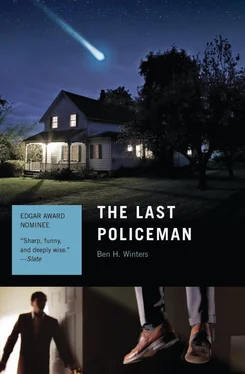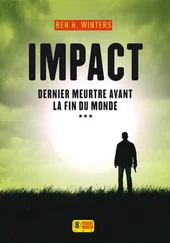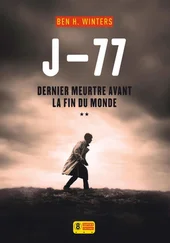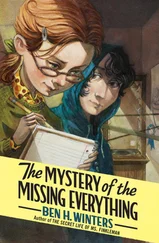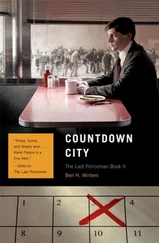“And so now I am going to lose my job, and everybody in this branch, they’re going to lose their jobs, too. And we’ll all be out on the street. So, I hope you have a pen handy, Detective, because I’ve got the information.”
I do have a pen, and Gompers gives me the information. The claim that Peter was working on when he died was filed in mid-November by a Ms. V. R. Jones, a director of the Open Vista Institute, a nonprofit corporation registered in the state of New Hampshire. Its headquarters are in New Castle, which is on the coast, near Portsmouth. It was a comprehensive life-insurance policy on the executive director, Mr. Bernard Talley, and Mr. Talley committed suicide in March, and Merrimack Life and Fire was exercising its right to investigate.
I write it all down, old habit, but it doesn’t matter and it never mattered, not even for a second.
Gompers is done and I say, “Thanks,” looking at the clock, it’s 9:02—any minute Fenton will call, she’ll give me the confirmation I need, and I’ll get in the car and go get the killer.
“Mr. Gompers, I recognize that you have made a sacrifice. But this is a murder investigation. It’s important.”
“You have no idea, young man,” he says morosely, “You have no idea what’s important.”
He hangs up, and I almost call him back. I swear to God, with all that’s going on, I almost get up and go over there. Because he’s not—he’s not going to make it.
But then the landline rings again, and I snatch it up again, and now it is Fenton, and she says, “Well, detective, how did you know?”
I take a breath, close my eyes, and listen to my heart pounding for a second, two seconds.
“Palace? Are you there?”
“I’m here,” I say, slowly. “Please tell me exactly what you’ve found.”
“Why certainly. I’d be happy to. And then at some point you are going to buy me a steak dinner.”
“Yep.” I say, opening my eyes now, peering at the crisp blue sky just beyond the kitchen window. “Just tell me what you’ve found.”
“You’re a lunatic,” she says. “MassSpec on the blood of Naomi Eddes confirms presence of morphine sulfate.”
“Right,” I say.
“This does not come as a surprise to you.”
“No, ma’am,” I say. No, it does not .
“Cause of death is unchanged. Massive craniocerebral trauma from gunshot wound in mid-forehead. But the victim of this gunshot had ingested a morphine derivative within the six- to eight-hour period prior to her death.”
It does not surprise me at all.
I close my eyes again, and I can picture Naomi leaving my house in her red dress in the middle of the night and going home to get high as a satellite. She must have been getting toward the end of her stash, too, must have been getting anxious about that, because now her dealer was dead. McGully had shot him. My fault.
Oh, Naomi. You could have told me .
I pull out my SIG Sauer from its holster and lay it on the kitchen table, open the magazine, empty out and count the dozen .357 bullets.
In the Somerset Diner, a week before, Naomi eating French fries, telling me that she had to help Peter Zell when she saw that he was suffering, that he was in withdrawal. She had to help him, she said, looked down, looked away.
I could have known it right then, had I wanted to know.
“I wish I could tell you more,” Fenton says. “If the girl had some hair on her head, I could tell you if she’s been using morphine for a long time.”
“Oh, yeah?”
I’m not really listening. Here’s a girl who felt compelled to help this random coworker, this man she barely knew, when she saw that he was suffering. Here’s a girl with her own long experience of drug addiction, who’s put her parents through hell, so much so that her father hangs up the phone as soon as he hears her name, hears the word policeman .
“If you’ve got a long enough piece of hair, you can cut it into quarter-inch sections, break them down and test them one by one,” Fenton says, “figure out what substances were metabolized, month by month. Pretty fascinating stuff, actually.”
“I’ll see you over there,” I say. “And I will. I’ll buy you that dinner.”
“Sure you will, Palace,” she says. “Around Christmas, right?”
I know what the hair test would have revealed. Naomi had been using, this time, for three months. I don’t know about her past usage, her periods of addiction and recovery and relapse, but this time she was using for almost three months exactly. Since Tuesday, January 3, when Professor Leonard Tolkin of the Jet Propulsion Lab went on television and gave her the same bad news he gave everybody else. My guess is, if she didn’t renew her active use of controlled substances that night, it was the day after, or the day after that.
I reload the magazine, snap it into place, depress the safety, and return my sidearm to the holster. I’ve already done this exercise in its entirety—open the magazine, check the bullets, close it up—several times since waking this morning at seven thirty.
Peter Zell had made his risk assessment and taken his plunge months before, gone through his whole cycle of attraction, experimentation, addiction, and withdrawal as the odds climbed steadily through the months. But Naomi, along with a lot of other people, took her own plunge only when it was official, when the odds of impact jumped all the way to one hundred percent. Millions of people all around the world deciding to get high as satellites and stay that way, scrambling for whatever they could—dope or junk or NyQuil or whippets or stolen bottles of hospital painkillers—and slip into pure pleasure mode, tune out the terror and the dread, in a world where the idea of long-term consequences had magically disappeared.
I will myself back in time, back to the Somerset Diner, reach across the table and take Naomi’s hands in my own, and I tell her to go ahead and tell me the truth, tell me about her weakness, and I’d tell her I don’t care and I’m going to fall for her anyway. I would have understood.
Would I have understood?
My father taught me about irony, and the irony here is that in October, when it was still fifty-fifty, when there was still hope, it was Naomi Eddes who had helped Peter Zell kick his stupid habit—helped him so well that when the end of the world was officially announced he fought through it, stayed clean. But Naomi, whose own addiction was deeper bred, whose habit was lifelong, not the result of a cold calculation of the odds… Naomi wasn’t that strong.
Another irony: it wasn’t so easy, in early January, to get ahold of drugs, especially the kind Naomi needed. New laws, new cops, demand spiking wildly, new choke points on supply, all the way up and down the line. But Naomi had known just where to go. She knew from her nightly conversations with Peter about his ongoing temptation: his old pal J. T. was still dealing, still getting morphine, in some form, from somewhere.
So that’s where she went, to the squat dirty house on Bow Bog Road, started buying, started using, never told Peter, never told anyone, and the only people who knew were Toussaint and the person who was his new supplier.
And that person—that person is the killer.
In the dark, at my house, frozen in the doorway, she almost told me the whole truth. Not only the truth about her addiction, but the truth about insurable interest, fraud claims, I thought of something that might be helpful to you, in your case . If I’d gotten out of bed, taken her wrists, kissed her and pulled her back into bed, she’d still be alive.
If she’d never met me, she’d still be alive.
I feel the weight of the gun in the holster, but I don’t take it out, not again. It’s ready, it’s loaded. I’m ready.
Читать дальше
